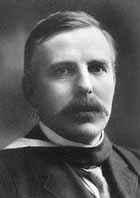 |
|
Idée Fixe
"It is ever a fixèd mark..." by Judy Jackson First of all, it has nothing to do with "broke." The "fixed" in "fixed-target experiment" means stationary, in one place, rooted to the spot. The opposite of the moving targets--speeding protons smacking speeding antiprotons, for example--of "colliding beam experiments."
Perhaps the most famous fixed-target experiment of all time was the one that started the whole gorgeous enterprise of subatomic physics, back in 1910. That's when Ernest Rutherford and his students sent alpha particles from a lump of radium (the particle beam) to a sheet of gold foil (the target) surrounded by screens of zinc sulfide (the detector). When alpha particles (helium atoms minus their electrons) passed through the gold foil and struck the screens, the collisions with zinc sulfide molecules made flashes that Rutherford's students, sitting for hours in the dark, could see. When--famously, astonishingly--some of the alpha particles bounced back from the gold foil target, Rutherford had discovered the atomic nucleus. Using a fixed-target experiment. From there, it took a mere 70-odd years and few thousand fixed-target experiments to create the Standard Model of Elementary Particles. (To be fair, a number of theorists and one or two collider experiments also helped, here and there.)
The fixed-target experiments that followed made extraordinary improvements and refinements in each of the three elements. "Rutherford's students had to sit around in the dark looking for particle events," observed Fermilab fixed-target physicists and Associate Director Mike Shaevitz. "Now we have computers that sit around in the dark for us. But it's the same principle." The principle: Particles in a beam collide with particles in a target, creating many secondary particles. The secondary particles may be objects of study in themselves, or experimenters may used them as probes of still other particles and forces. Over the years, physicists learned to use accelerators to make particle beams millions of times more powerful and vastly more intense than Rutherford's alpha particles. They learned to choose targets of different materials and different sizes and shapes to suit the objects of their interest. They built detectors of dazzling intricacy, scope and precision. They programmed computers to sit in the dark and watch. By varying the beam energy and changing the target, Fermilab physicists learned to take a beam of protons from the Tevatron and create an entire menu of secondary beams. Using magnetic fields, absorbers and other clever tricks to sweep away the extraneous particles produced in collisions at the target, they created an array of designer beams for their experiments: Kaons Pions Muons Neutrons Photons Electrons Neutrinos And their antiparticles
Some metaphors for fixed-target experiments: If we think of collider experiments as power tools for a broad range of discoveries, we can think of fixed-target experiments as a set of scalpels to dissect particular particles and processes. The machine tool versus the surgeon's knife. Fermilab physicist and Associate Director Steve Holmes compares a fixed-target experiment to a pinata at a birthday party. The pinata hangs there, and kids whack it with a baseball bat until goodies fall out. Perhaps this is more the point of view of an accelerator builder (the whacker) than of the experimentalists, who might feel they play a more active role than merely waiting to see what falls out. But you get the idea. Fixed-target experiments often explore the behavior of secondary particles created by proton beams. Fermilab's KTeV, for example, made beams of kaons and studied their decay, to confirm the asymmetry between matter and antimatter. MINOS will create a beam of muon neutrinos and scrutinize them for signs of oscillation to tau neutrinos, as evidence for neutrino mass. Alternatively, experimenters may create beams of secondary particles to use as probes for exploring still other phenomena. NuTeV used a beam of neutrinos to study the properties of protons. FOCUS used a photon beam to study charm quarks. Beginning with Rutherford's discovery of the nucleus, which started it all, fixed-target experiments have progressively illuminated the subatomic world of quarks and leptons, and the forces at play among them. In a particle-physics world now dominated by the high-energy of colliders, fixed-target experiments will continue to create unique opportunities for insight into the fundamental nature of matter. |
| last modified 6/30/2000 email Fermilab |
FRLsDFx9eyfrPXgV
 To make a fixed-target experiment, you need three things: a beam of particles, a target and a detector to see what happens after you hit the target with the particles. (Strictly speaking, as fixed-target maven Leon Lederman points out, you also need a fourth thing: the funding to build the other three.)
To make a fixed-target experiment, you need three things: a beam of particles, a target and a detector to see what happens after you hit the target with the particles. (Strictly speaking, as fixed-target maven Leon Lederman points out, you also need a fourth thing: the funding to build the other three.)
 All the fixed-target experiments that have followed Grandaddy Rutherford's first foray into the atom are really just more sophisticated--much more sophisticated--versions of that
first simple model: particle beam, target, detector. (What about the fourth element, funding? Did Cambridge University fund Rutherford's experiment? How much did it cost? One imagines the funding committee for the Cavendish Laboratory: "Do you have to use gold foil? Couldn't you use copper? How about balsa wood?")
All the fixed-target experiments that have followed Grandaddy Rutherford's first foray into the atom are really just more sophisticated--much more sophisticated--versions of that
first simple model: particle beam, target, detector. (What about the fourth element, funding? Did Cambridge University fund Rutherford's experiment? How much did it cost? One imagines the funding committee for the Cavendish Laboratory: "Do you have to use gold foil? Couldn't you use copper? How about balsa wood?")